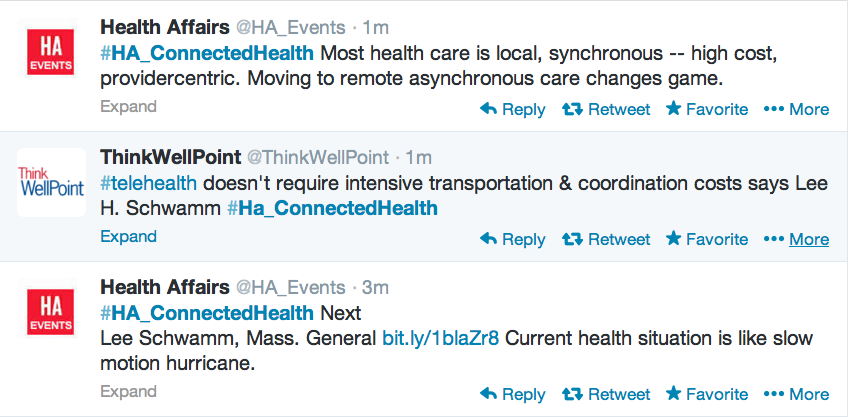Karen B. DeSalvo, MD, MPH, MSc, is National Coordinator for Health Information Technology at the U.S. Department of Health and Human Services. Before coming to the Office of the National Coordinator for Health IT, she was the New Orleans health commissioner and New Orleans Mayor Mitchell Landrieu’s senior health policy advisor. Earlier, Dr. DeSalvo was a professor of medicine and vice dean for community affairs and health policy at Tulane University School of Medicine. Following Hurricane Katrina, she created an innovative model of neighborhood-based primary care and mental health services for low-income, uninsured and other vulnerable individuals, and was the founder and president of 504HealthNet, a consortium of safety net providers in the New Orleans region.Conference agenda pdf file here. Link to the conference slides here.
Nice that she gave the RECs a couple of shout-outs. Now if only Congress would extend REC funding.
Dr. DeSalvo fielded a tough interoperability question after her talk. Don't get me started.
Some early tweets. Hashtag #HA_ConnectedHealth
PRIVACY AND SECURITY ISSUES
This is a really thorny area. A rapidly moving target.
UPDATE: DOC GURLEY TWEET
That's simply the finest compliment I've ever had. Thank you! Doc Gurley has long been my hero.
__
POST-BREAK SESSION: RURAL ISSUES
I recently left Las Vegas and moved to the Bay Area after retiring from the Nevada REC. Almost the entire huge state of Nevada is classified as "frontier" (7 or fewer residents per square mile, IIRC). TeleHealth technology will have to be part of the solution in the frontier locales.
ANOTHER SAMPLE OF TWEETS
Below: another nice slide
Indeed.
Another. "The 5,000 hour problem," i.e., your routine annual waking hours versus the time spent explicitly engaging the health care system.
The promise of TeleHealth. "Health" (or lack of it) happens mostly while you're not in the doctor's office. Leveraging TeleHealth technologies can significantly improve health. I would think this impact will only grow as technolieis improve and policies align rationally.
Great conference. Well worth getting up at 5 a.m. here in the Bay Area to attend via webcast.
__
IN OTHER NEWS TODAY
This is worrisome. The next Health IT CusterFluck?
Practices badly lagging on ICD-10Recall my post "ICD-10: W6142XA, Struck by turkey, initial encounter"
It is imperative that CMS show leadership,' says MGMA
ENGLEWOOD, CO | February 5, 2014
Just eight months out from the ICD-10 compliance date, fewer than 10 percent of physician practices say they've made significant progress in their readiness for implementation, according to the Medical Group Management Association.
As such, MGMA is urging the Centers for Medicare & Medicaid Services to "immediately take action" to help get practices on track.
"The critical coordination that must take place between practices and their software vendor, clearinghouse and health plan partners is simply not happening at the pace required for a seamless implementation," said MGMA President and CEO Susan L. Turney, MD in a press statement.
"Very simply, ICD-10 is behind schedule," she said. "MGMA continues to advocate on behalf of members and provide tools and resources to help practice executives make the transition to ICD-10 more cost effective and less disruptive to their organizations."...
DOC GURLEY UPDATE
Medical Homes Part 1: The Reality vs. The Hype
February 1st, 2014
Patient-Centered Primary Care Medical Homes (PCMHs) are all the rage. A frequently-touted part of the Affordable Care Act (ACA), they have received literally hundreds of millions of dollars in federal incentive and demonstration-project funding. They’ve been around for decades. In fact, the more you know about the intention behind the creation of a primary care Patient-Centered Medical Home (PCMH), the more you want to ask, “Well, of course – how could that not be a good idea?”Yikes. Can't wait to read this entire series. Click the title for the link to Dr. Gurley's full post.
But is it?
Creating a medical home means building and using an integrated approach to health care where each piece of care is not treated separately and does not take place in isolation – nor is it all billed separately. Health care, communication, co-ordination, complications, follow-up and payment are all part of one system led by primary care...
...But all this time and effort to make things “patient centered” has to be worth something, right? Or is it just bad bureaucracy taking over another part of health care? Bad bureaucracy in health care isn’t just annoying. Estimates are that it eats up one third of our health care budget or as much money as it would take to care for all the uninsured. PCMHs stand to create more. As one example, between 2010 and 2012, New York’s state Medicaid program spent an estimated $398,947,964 taxpayer dollars (which includes a $250 million lump sum payment to hospitals and training centers) – from money designated for the health care of New York’s poorest, and often most medically fragile and disabled patients – to implement this certification bureaucracy.
In my next post, Medical Homes: Part II, The Depressing Data, I will round up and summarize for you what the investment of millions of dollars has actually produced. Afterwards, in Medical Homes: Part III, The True Cost, I’ll examine how the certification and implementation process takes time and resources away from patient care.
CODA
Oops...
The Health Care Blog has apparently been infected with malware. It has persisted all day.
___
More to come...













No comments:
Post a Comment